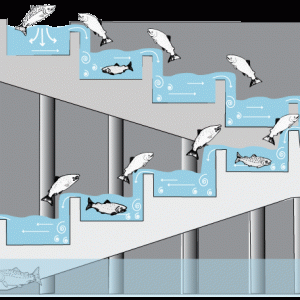With a cool fall breeze we beached our kayaks and hopped onto the bank. A long tiring paddle up the river has taken us here, we are at the fish ladder. During our River Rat patrol last Friday, we took time to explore the Bosher Dam. This is a historic dam, constructed in 1835. Our River Rat control determined that wildlife was abundant, and trash in the area was at a minimum. We also saw the pinnacle of all things to improve the health of the James, was the fish ladder. Although not operational last week, during peak migration season the Bosher Dam fish ladder successfully helps fish move up and down the river. From our visit to the Bonneville Dam, we learned about how important fish ladders are to the ecosystem. Fish ladders are one of the most important tools to improve the health of the river, yet the Bosher Dam fish ladder was not contrasted until 1999. Why is this? What took so long and how much damage did the river receive? Historically, fish ladders have existed in France since the 17th century. Despite this, modern fish ladders have not been implemented into there was proof that they are beneficial for the river, and that proof only came from scientific research.
Looking at a small section of the river, it may not seem like fish ladders are required. Scale is important to consider because realistically that fish doesn’t actually have to move to the other side of the dam to survive. Food and habitat is still abundant on the down river side. One has to look at larger scale, both physical and time, to find importance of fish ladders. Many species, like the sturgeon we study in class, migrate up and down the river for different life stages. So yes, that one fish will survive if there was no fish ladder, and it was stuck on one side of the dam. But all of the generations after will suffer and successful breeding may be reduced to zero. After this the region where the fish used to travel will be effected. No longer will that fish be hunting on the smaller organisms and other food sources. The balance of the ecosystem will be thrown off, and we can only hope will be able to recover without that once important species once there.
For all of these reasons fish ladders have been proven successful. Research like this drives public policy, and without any research there would be a lack of informed decision making. This is why federal funding for long term projects, like those undertaken in the Andrews Experimental Forest are important. The HJA itself did not produce fish ladder studies, but many scientific discoveries have been made there, as is described in my blog on the subject. Nevertheless, some recently published studies have suggested that fish ladders do not promote safe travel up river, instead they actually have a negative effect by allowing predators access to the very species the ladder was designed to protect. (Agostino et al. 2012) Research is not binary. Fish ladders cannot not switch from being inherently good nor bad. One study does change conventional wisdom. Instead long term studies can show general trends, and without these it is hard to put all the puzzle pieces together in order to save our great James River.


